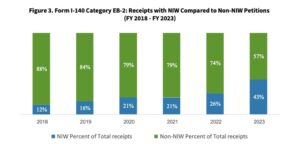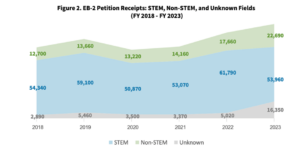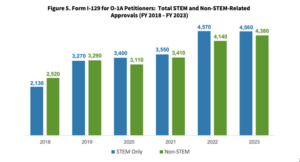A recent analysis by U.S. Citizenship and Immigration Services (USCIS) found that the number of petitions by, or on behalf of, foreign-born workers in the fields of science, technology, engineering, and math (STEM) increased following a pair of guidance clarifications the agency made in January 2022.
One outlines how foreign-born STEM professionals can qualify for an employment-based visa category (the EB-2) on their own, without first securing a job offer. The other clarifies how STEM professionals can meet the eligibility criteria for the O-1A visa category for extraordinary ability. The shifts are part of ongoing efforts by the administration to alleviate critical STEM-workforce shortages to help U.S. businesses succeed and better compete in the global economy.
“I’m seeing more aspiring and early-stage startup founders believe there’s a way forward for them,” Sophie Alcorn, an immigration lawyer in Silicon Valley, told Science magazine.
National Interest Waiver (NIW) in the Employment-Based Second-Preference Category
The employment-based, second-preference visa category, the EB-2, is a path for professionals with an advanced degree or its equivalent, or people with exceptional ability, to become U.S. lawful permanent residents.
Typically, the noncitizen must have a job offer from an employer and the employer must demonstrate to the U.S. Department of Labor that no qualified U.S. workers are available for the job. The employer can then file a petition with USCIS on the noncitizen’s behalf for the EB-2 visa category. However, the Department of Labor is taking more than a year to process labor certification applications, which may dissuade some employers and workers from pursuing this visa category.
Noncitizens have had the option to file a petition with USCIS on their own and ask that the job offer requirement be waived. To do so, they must demonstrate how their work would be in the national interest. But this route proved challenging for those in STEM fields, as their accomplishments did not fit into the framework USCIS officers were using to assess this national interest waiver (NIW) request.
The 2022 updated guidelines appear to attempt to resolve this issue. The guidelines add a section noting the value of STEM professionals, specifically giving “strong, positive” consideration to those with advanced STEM degrees whose work advances U.S. competitiveness.
As a result, the percentage of EB-2 petitions with a national interest waiver request has grown, from 21% of petitions in FY 2021 to 26% of petitions in FY 2022 and 43% of petitions in FY 2023.

Source: USCIS
The number of EB-2 visa petitions also rose, from 70,600 in fiscal year 2021 to 93,010 in FY 2023, an increase of 31.7%. The number of petitions in the STEM category increased from 53,070 in FY 2021 to 61,790 in FY 2022 but dropped to 53,960 in FY 2023.

Source: USCIS
The number of EB-2 petitions that USCIS approved increased by 60% between FY 2021 and FY 2022 but dropped 12% between FY 2022 and FY 2023.
O-1A
USCIS also clarified how it evaluates petitions in the O-1A visa category for noncitizens with “extraordinary ability” in STEM fields. Previously, USCIS did not specifically address how extraordinary ability could be demonstrated with documentation that’s common for workers in STEM fields.
In the 2022 update, however, the agency provides examples of evidence that may satisfy the criteria for the O-1A visa category, with a focus on STEM. These include:
- Awards from “well-known” national institutions or professional associations; certain doctoral dissertation awards or Ph.D. scholarships; or conference-presentation awards.
- Membership in or fellowships with certain professional associations or institutions.
- Senior faculty or research positions at distinguished academic or non-academic institutions; founder or essential role with a distinguished startup or intellectual-property contributor to it; and more.
The update also, according to USCIS, “discusses considerations that are relevant to evaluating such evidence, with a focus on the highly technical nature of STEM fields and the complexity of the evidence often submitted.”
Following the release of the updated policy guidance, the number of O-1A petitions increased by 29.8%, from 7,710 in FY 2021 to 10,010 in FY 2023, and the number of approvals increased by 29.6%, from 7,320 in FY 2021 to 9,490 in FY 2023. Most were in STEM fields, where approvals increased by 28.5%, from 3,550 in FY 2021 to 4,560 in FY 2023.

Source: USCIS
In September 2023, USCIS issued similar clarifications for the EB-1A extraordinary ability category. Like the EB-2 visa category, the EB-1A offers immigrants pathway to U.S. lawful permanent residence. The extraordinary ability visa categories have similar requirements, but USCIS approval of an O-1A petition for temporary work does not guarantee approval of an EB-1A extraordinary ability petition.
STEM shortages
The policies are a good start to help relieve the nation’s critical and growing shortage of scientifically and technically skilled workers, especially in private industries.
A 2023 study by the Semiconductor Industry Association and Oxford Economics estimated that an additional 3.85 million jobs requiring proficiency in technical fields will be created in the United States by 2030, and that 1.4 million of those risk going unfilled “unless we can expand the pipeline for such workers in fields such as skilled technicians, engineering, and computer science.” The semiconductor industry alone risks being unable to fill 58 percent of new jobs created to expand chip manufacturing in the United States.
Similarly, “82 percent of companies in the defense industrial base report that it is difficult to find qualified STEM workers,” National Defense Magazine reported in 2023. “The ability to attract foreign-born talent is one of the nation’s greatest asymmetric advantages,” the authors write. But decades-long waits for green cards and a lack of visa options means that “an estimated 80 to 90 percent of students receiving advanced degrees in highly desirable STEM fields are forced to leave the country after graduation, greatly depleting America’s potential workforce.”
Clarifying agency guidance for documentation to allow more STEM workers to stay and work in the United States is a good start, but if America is to remain innovative and competitive, Congress needs to enact changes that reflect workforce needs while protecting U.S. and foreign workers.
FILED UNDER: STEM, USCIS


